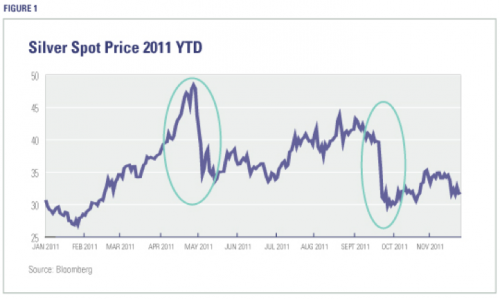Silver Producers: A Call to Action
by Eric Sprott and David Baker
November 29, 2011
As we approach the end of 2011, the silver spot price has admittedly endured a tougher road than we would have expected. And let’s be honest – what investment firm on earth has pounded the table on silver harder than we have? After the orchestrated silver sell-off in May 2011 (please see June 2011 MAAG article entitled, "Caveat Venditor"), silver promptly rose back to US$40/oz where it consolidated nicely, only to drop back below US$30 within a two week span in late September.1 The September sell-off was partly due to the market’s disappointment over Bernanke’s Operation Twist, which sounded interesting but didn’t involve any real money printing. Like the May sell-off before it, however, it was also exacerbated by a seemingly needless 21% margin rate hike by the CME on September 23rd, followed by a 20% margin hike by the Shanghai Gold Exchange – the CME’s counterpart in China, three days later.
The paper markets still dictate the spot market for physical gold and silver. When we talk about the "paper market", we’re referring to any paper contract that claims to have an underlying link to the price of gold or silver, and we’re referring to contracts that are almost always levered. It’s highly questionable today whether the paper market has any true link to the physical market for gold and silver, and the futures market is the most obvious and influential "paper market" offender. When the futures exchanges like the CME hike margin rates unexpectedly, it’s usually under the pretense of protecting the "integrity of the exchange" by increasing the collateral (money) required to hold a position, both for the long (future buyer) and the short (future seller). When they unexpectedly raise margin requirements two days after silver has already declined by 22%, however, who do you think that margin increase hurts the most? The long buyer, or the short seller? By raising the margin requirement at the very moment the long contracts have already received an initial margin call (because the price of silver has dropped), they end up doubling the longs’ pain – essentially forcing them to sell their contracts. This in turn creates even more downward price pressure, and ends up exacerbating the very risks the margin hikes were allegedly designed to address.
When reviewing the performance of silver this year, it’s important to acknowledge that nothing fundamentally changed in the physical silver market during the sell-offs in May or mid-September. In both instances, the sell-offs were intensified by unexpected margin rate hikes on the heels of an initial price decline. It should also come as no surprise to readers that the "shorts" took advantage of the September sell-off by significantly reducing their silver short positions.2 Should physical silver be priced off these futures contracts? Absolutely not. That they have any relationship at all is somewhat laughable at this point. But futures contracts continue to heavily influence spot prices all the same, and as long as the "longs" settle futures contracts in cash, which they almost always do, the futures market-induced whipsawing will likely continue. It also serves to note that the class action lawsuits launched against two major banks for silver manipulation remain unresolved today, as does the ongoing CFTC investigation into silver manipulation which has yet to bear any discernible results.3
Meanwhile, despite the needless volatility triggered by the paper market, the physical market for silver has never been stronger. If the September sell-off proved anything, it’s the simple fact that PHYSICAL buyers of silver are not frightened by volatility. They view dips as buying opportunities, and they buy in size. During the month of September, the US Mint reported the second highest sales of physical silver coins in its history, with the majority of sales made in the last two weeks of the month.4 Reports from India in early October indicated that physical silver demand had created short-term supply issues for physical delivery due to problems with airline capacity.5 In China, which reportedly imported 264.69 tons (7.7 million oz) of silver in September alone, the volume of silver forward contracts on the Shanghai Gold Exchange was more than six times higher than the same period in 2010.6,7 It was clear to anyone following the silver market that the physical demand for the metal actually increased during the paper price decline. And why shouldn’t it? Have you been following Europe lately? Do the politicians and bureaucrats there give you confidence? Gold and silver are the most rational financial assets to own in this type of environment because they are no one’s liability. They are perfectly designed to protect us during these periods of extreme financial turmoil. And wouldn’t you know it, despite the volatility, gold and silver have continued to do their job in 2011. As we write this, in Canadian dollars, gold is up 23.4% on the year and silver’s up 6.8%. Meanwhile, the S&P/TSX is down -12.3%, the S&P 500 is down -5.1% and the DJIA is up a mere +0.26%.8











